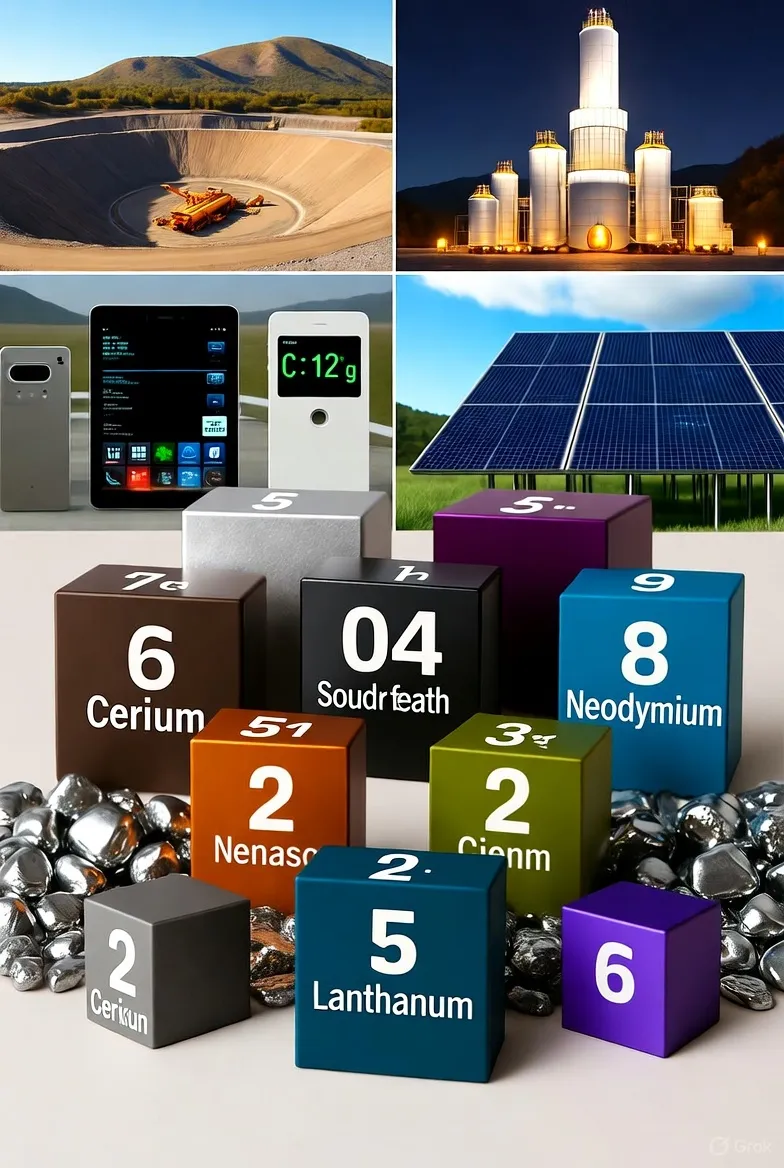Rare earth elements (REEs) a group of 17 critical minerals form the backbone of modern technology, clean energy, and defense industries. Valued at $3.95 billion in 2024, the global rare earth market is projected to reach $37 billion by 2033, according to the U.S. Geological Survey (USGS 2025).
The United States currently depends on China for 70 percent of its imports, leaving its supply chains vulnerable to trade restrictions. In 2025, Beijing’s export limits on twelve elements triggered price spikes and supply disruptions, prompting Washington to invest $540 million in domestic production with the goal of cutting dependency to below 50 percent by 2030.
What Are Rare Earth Elements and Why They Matter
REEs include scandium (Sc), yttrium (Y), and the fifteen lanthanides, ranging from lanthanum (La) to lutetium (Lu). Despite the term “rare,” minerals such as cerium are more abundant in Earth’s crust than copper.
Their unique magnetic, fluorescent, and conductive properties make them indispensable in everything from smartphones and electric vehicles to military jet systems and medical imaging.
Light rare earths like neodymium and cerium dominate global supply, powering catalytic converters and wind-turbine magnets, while heavy rare earths such as dysprosium and terbium enhance high-temperature magnet performance.
Extraction and Refining: High Demand, High Cost
Most REEs are mined from bastnäsite and monazite ores, primarily in China’s Bayan Obo region, which alone accounts for 60 percent of global output.
Extraction involves crushing, grinding, and chemical separation using strong acids processes that generate toxic waste containing thorium and uranium.
By 2025, global output reached 390,000 tons of REE oxide, 92 percent of which is refined in China (IEA data). U.S. start-ups like Phoenix Tailings are now pioneering zero-waste electric refining in New Hampshire to reduce environmental damage.
Economic and Strategic Importance
The REE sector contributes directly to the green economy, expanding at roughly 8.6 percent annually. Each megawatt of wind energy requires about 171 kg of REEs, while every F-35 fighter jet contains over 400 kg.
The U.S. Defense Production Act has funded domestic producers like MP Materials and USA Rare Earth to build a secure supply chain.
Stock prices of rare-earth companies surged in 2025 MP Materials rose 50 percent after a $400 million Pentagon investment underscoring the market’s growing strategic value.
Environmental and Regulatory Challenges
Refining rare earths creates radioactive and chemical waste, contaminating water and soil.
The U.S. EPA enforces stricter standards than China, increasing production costs by about 30 percent. To mitigate damage, innovators like Phoenix Tailings and Energy Fuels employ electric-based processing and carbon-capture systems.
Global initiatives such as the Clean Energy Act 2025 and the EU Critical Minerals Strategy aim to enforce recycling and sustainability targets that could cut emissions by half by 2030.
Global Power Shift: From China to New Alliances
China still dominates global refining capacity %90 but nations like Australia, the U.S., and the UAE are expanding domestic projects.
Australia plans to triple output by 2027, while the U.S. seeks to achieve full-cycle independence by 2035. The rise of “green mining” and AI-based process optimization is redefining the global REE supply map.
The Future of Rare Earths: From Scarcity to Sustainability
The rare-earth industry is evolving from an overlooked niche into a cornerstone of national security, clean energy, and digital innovation.
With increasing demand for EVs, wind turbines, and AI-driven electronics, these minerals will remain vital for decades shaping the economic balance between nations.
If managed responsibly, REEs could power not only the world’s green transition but also a new era of technological sovereignty.
